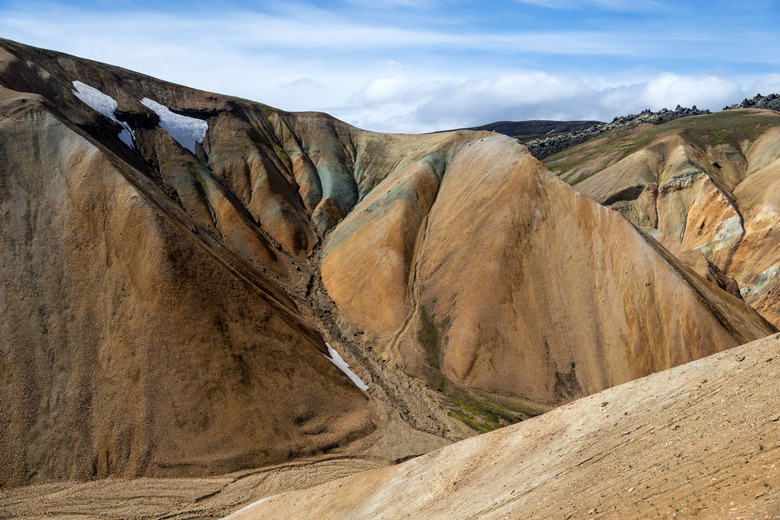Three Types Of Convergent Boundaries
The Earth's lithosphere, composed of the outer crust and the rigid, uppermost section of the mantle, is divided into mobile segments called tectonic plates on which the oceans and continents ride. Plates can diverge or slide past one another; where they collide, they form tumultuous convergent boundaries, where one plate is either destroyed – hence the alternate term destructive plate boundaries – or jams up against the other. Convergent boundary types include oceanic/oceanic, oceanic/continental and continental/continental.
TL;DR (Too Long; Didn't Read)
Convergent boundaries occur where tectonic plates collide, which takes place where two oceanic plates meet, where two continental plates meet or where an oceanic plate meets a continental plate.
Oceanic/Oceanic Convergent Boundaries
Oceanic/Oceanic Convergent Boundaries
Where different oceanic plates run into each other, the older – and therefore cooler and denser – one dives beneath the other; in other words, it subducts. Such a convergent boundary includes a seafloor trench marking the earthquake-rattled subduction zone as well as an island arc: a line of volcanoes created by rock-melt in the mantle associated with subduction. Other features of an oceanic/oceanic convergent boundary are the forearc basin between the trench and the island arc and the backarc basin on the opposite side of the arc.
An example of an oceanic/oceanic convergent boundary is that between the Pacific and Mariana plates, which includes the Mariana Islands arc and a subduction zone encompassing the Mariana Trench, the deepest part of the World Ocean. The World Ocean is the name for the collective group of oceans on the planet.
Oceanic/Continental Convergent Boundaries
Oceanic/Continental Convergent Boundaries
Where oceanic and continental plates collide, the former subducts beneath the latter because ocean crust – rich in iron and magnesium – is denser than continental rock. Here again a subduction zone occurs, as does a volcanic arc that develops on the continental side of the boundary; in between, sediments sloughed up against the continental margin form an accretionary wedge.
The western coast of the Americas – part of the Pacific Ring of Fire, named for the Pacific basin's energetic volcanic and seismic turmoil – hosts this type of tectonic convergence. Along the Pacific Northwest coast, for example, oceanic plates subducting beneath the North American Plate create the Cascadia Subduction Zone, fueling the Cascade Range volcanoes; the Nazca (and, to a lesser extent, Antarctic) plate subducting under the South American Plate, meanwhile, uplifted the Andes and peppered that towering range with volcanoes. Both regions are vulnerable to severe earthquakes associated with this intense plate collision.
Continental/Continental Convergent Boundaries
Continental/Continental Convergent Boundaries
Convergent boundaries between continental plates are a bit different than oceanic/oceanic and oceanic/continental mashups. Continental lithosphere is too buoyant to subduct deeply, so rather than a subduction zone and trench these boundaries encompass a thick mess of folded, piled-up crust. This compression results in massive mountain belts rather than the volcanic arcs powered by subduction-zone magma in the other two cases.
The classic example of a continental/continental convergent boundary is the rumpled overlap where the Indian Plate drives into the Eurasian Plate, a tectonic collision that has thrown up the greatest mountains in the world – the Himalayas – as well as the vast, high Tibetan Plateau. To the west, the Alps grew in similar fashion via the collision of the African and Eurasian plates.
Cite This Article
MLA
Shaw, Ethan. "Three Types Of Convergent Boundaries" sciencing.com, https://www.sciencing.com/three-types-convergent-boundaries-7501192/. 20 April 2018.
APA
Shaw, Ethan. (2018, April 20). Three Types Of Convergent Boundaries. sciencing.com. Retrieved from https://www.sciencing.com/three-types-convergent-boundaries-7501192/
Chicago
Shaw, Ethan. Three Types Of Convergent Boundaries last modified March 24, 2022. https://www.sciencing.com/three-types-convergent-boundaries-7501192/
